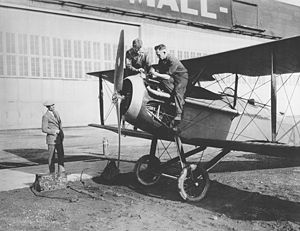Vought VE-7
| VE-7 | |
|---|---|
 |
|
| Mechanics work on a VE-7 | |
| Role | Fighter & Trainer |
| Manufacturer | Lewis & Vought Corporation |
| Designer | Chance M. Vought |
| First flight | 1917 |
| Primary users |
United States Navy United States Army Air Service |
| Produced | 1918-1928 |
| Number built | 128 |
The Vought VE-7 "Bluebird" was an early biplane of the United States. First flying in 1917, it was designed as a two-seat trainer for the United States Army, then adopted by the United States Navy as its very first fighter aircraft. In 1922, a VE-7 became the first plane to take off from an American aircraft carrier.
The Lewis & Vought Corporation was formed just months after the U.S. entered World War I, with the intention of servicing war needs. The company's trainer was patterned after successful European designs; for instance, the engine was a Wright Hispano Suiza of the type used by the French Spads. In practice, the VE-7's performance was much better than usual for a trainer, and comparable to the best fighters, and the Army ordered 1,000 of an improved design called the VE-8. However, the contract was cancelled due to the end of the war.
However, the Navy was very interested in the VE-7, and received a first machine in May 1920. Production orders soon followed, in fact beyond what the fledgling Vought organization could handle, and the Naval Aircraft Factory was pressed into service. In all, 128 VE-7s were built.
The fighter version of the VE-7 was designated VE-7S. It was a single-seater, the front cockpit being faired over and a .30 in (7.62 mm) Vickers machine gun mounted over it, on the left side and synchronized to fire through the propeller. Some planes, designated VE-7SF, had floatation gear consisting of inflatable bags stowed away, available to help keep the plane afloat when ditching at sea.
The Bluebird won the 1918 Army competition for advanced training machines.
The VE-8 variant completed in July 1919 had a 340hp Wright-Hispano H engine, reduced overall dimensions, increased wing area, a shorter faired cabane, and two Vickers guns. Two were completed. Flight test results were disappointing, the aircraft was overweight, with heavy controls, inadequate stability and sluggish performance.
...
Wikipedia
